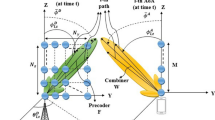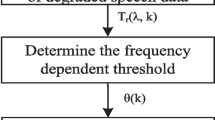Abstract
The optimal microphone array, in the sense of minimum mean square errors (MMSE), includes two processing blocks: the minimum variance distortionless response (MVDR) beamformer and the single-channel Wiener filter, which acts as post-filter. In this paper, we propose a new post-filter algorithm based on assumptions that both the noise power attenuation factor (NPAF) and signal power attenuation factor (SPAF) are time invariant in the reverberant room. The algorithm recursively estimates both factors from available measurements and uses them in estimation of the post-filter parameters. Additionally, to overcome the problem of the poor performance of the MVDR beamformer in reverberant conditions, we propose the usage of the two-step (TS) MVDR algorithm. This algorithm improves the robustness of the beamformer and its ability to suppress the interferences using an estimate of the desired speaker transfer function. Although TS MVDR beamformer and proposed post-filter can work separately, or combined with other algorithms, the best performance is obtained when they work together. The performance of the proposed combination of new post-filter algorithm and TS MVDR beamformer is tested in a simulated reverberant room and compared with similar algorithms, which gave rather good results.
Similar content being viewed by others
References
J.B. Allen, D.A. Berkley, Image method for efficiently simulating small-room acoustics. J. Acoust. Soc. Am. 65(4), 943–950 (1979)
S. Araki, S. Makino, Y. Hinamoto, R. Mukai, T. Nishikawa, H. Saruwatari, Equivalence between frequency-domain blind source separation and frequency-domain adaptive beamforming for convolutive mixtures. EURASIP J. Appl. Signal Process. 2003(11), 1157–1166 (2003)
J.G. Beerends, A.P. Hekstra, A.W. Rix, M.P. Hollier, Perceptual evaluation of speech quality (PESQ). The new ITU standard for end-to-end speech quality assessment. Part II: psychoacoustic model. J. Audio Eng. Soc. 50(10), 765–778 (2002)
ETSI EG 202 396-1: Speech quality performance in the presence of background noise. Part 1: Background noise simulation technique and background noise database. http://portal.etsi.org/docbox/stq/Open/EG202396-1Backgroundnoisedatabase/Binaural_Signals/
S. Gannot, D. Burshtein, E. Weinstein, Signal enhancement using beamforming and nonstationarity with applications to speech. IEEE Trans. Signal Process. 49(8), 1614–1626 (2001)
J.E. Greenberg, P.M. Zurek, Evaluation of an adaptive beamforming method for hearing aids. J. Acoust. Soc. Am. 91(3), 1662–1676 (1992)
O. Hoshuyama et al., A realtime robust adaptive microphone array controlled by an SNR estimate, in Proc. ICASSP98 (1998), pp. 3605–3608
S.T. Jovicic, Z.M. Saric, R.T. Srbijanka, Application of the maximum signal to interference ratio criterion to the adaptive microphone array. Acoust. Res. Lett. Online 6(4), 232–237 (2005)
S. Jovicic, Z. Saric, Adaptive microphone array free of the desired speaker cancellation combined with post filter, in Acoustics 08, Paris (2008), pp. 5143–5147
C. Marro, Y. Mahieux, K.U. Simmer, Analysis of noise reduction and dereverberation techniques based on microphone arrays with postfiltering. IEEE Trans. Speech Audio Process. 6(3), 240–259 (1998)
I.A. McCowan, H. Bourlard, Microphone array post-filter for diffuse noise field, in Proc. ICASSP-02 (Springer, Berlin, 2002), pp. 905–908
I. McCowan, H. Bourlard, Microphone array post-filter based on noise field coherence. IEEE Trans. Speech Audio Process. 11(6) (2003)
I.I. Papp, Z.M. Šarić, S.T. Jovičić, N. Teslić, Adaptive microphone array for unknown desired speaker’s transfer function. JASA Express Lett. 122(2), EL44–49 (2007)
L. Parra, C. Alvino, Geometric source separation: merging convolutive source separation with geometric beamforming. IEEE Trans. Speech Audio Process. 10(6), 352–362 (2002)
L. Parra, C. Spence, Convolutive blind separation of non-stationary sources. IEEE Trans. Speech Audio Process. 8(3), 320–327 (2000)
A.W. Rix, M.P. Hollier, A.P. Hekstra, J.G. Beerends, Perceptual evaluation of speech quality (PESQ). The new ITU standard for end-to-end speech quality assessment. Part I—time-delay compensation. J. Audio Eng. Soc. 50(10), 755–764 (2002)
Z.M. Saric, S.T. Jovicic, Adaptive microphone array based on pause detection. Acoust. Res. Lett. Online, 5(2), 68–74 (2004)
Z.M. Saric, S.T. Jovicic, M. Janev, I.I. Papp, Z.S. Marceta, Microphone array post-filter based on noise power attenuation factor and a priori knowledge of the noise field coherence, in Proc. of International Conference SPECOM 2007, Moscow, Russia (2007), pp. 252–258
K.U. Simmer, J. Bitzer, C. Marro, Post-filtering techniques, in Microphone Arrays, ed. by M. Brandstein, D. Ward (Springer, New York, 2001), pp. 36–60
H.L.V. Trees, Optimum Array Processing—Part IV (Wiley, New York, 2002)
B. Widrow, S.D. Stearns, Adaptive Signal Processing (Englewood Cliffs, Prentice-Hall, 1985)
O. Yilmaz, S. Rickard, Blind separation of speech mixtures via time-frequency masking. IEEE Trans. Signal Process. 52(7), 1830–1847 (2004)
R. Zelinski, A microphone array with adaptive post-filtering for noise reduction in reverberant rooms, in Proc. ICASSP88 (Springer, Berlin, 1988), pp. 2578–2581
Author information
Authors and Affiliations
Corresponding author
Rights and permissions
About this article
Cite this article
Saric, Z.M., Simic, D.P. & Jovicic, S.T. A New Post-filter Algorithm Combined with Two-step Adaptive Beamformer. Circuits Syst Signal Process 30, 483–500 (2011). https://doi.org/10.1007/s00034-010-9233-1
Received:
Revised:
Published:
Issue Date:
DOI: https://doi.org/10.1007/s00034-010-9233-1




